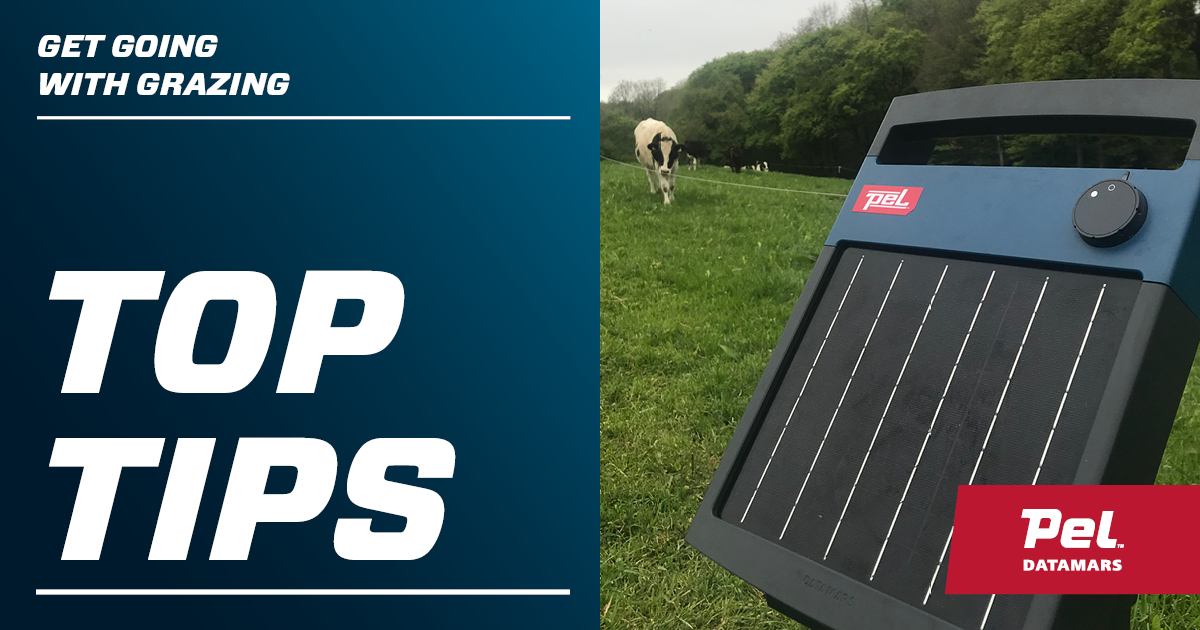Electric Fencing
Get Going with Grazing
Datamars Livestock, featuring Pel Electric Fencing are running a weeklong series entitled Get Going with Grazing to help people who want to start doing rotational grazing to improve their grass quality, soil structure and grazing potential on their farm.
Starting off using Electric Fencing to improve your grazing can be very simple. All you need is 1 geared reel for cattle, 3 for sheep, some polywire and a few posts for strip grazing and a few more if you want to try rotational grazing, be it youngstock, older cattle or sheep.
Start by splitting a field into smaller paddocks on part of your farm until you feel confident to extend it to a wider area. Split your fields into paddocks and work on 6-8 sheep per hectare or 1 cow and calf per hectare. Start with six paddocks and rotate the stock every four days, or eight paddocks, moving every three days, making a 24 day rotation.
This will help ensure that you start grazing at the optimum stage and leave the field with the right residuals. We will talk in more detail regarding dry matter in other posts, but in simple terms put the stock in when the grass is just above ankle height in wellingtons and take them out when its down to the toe of your wellington boot. You don’t necessarily need a plate meter and farm software when starting off, but we will come back to that later. Keep it simple to start with and move the stock into the paddock with the most grass.
Tip 1 – Keep it simple – You don’t need software, plate meters and complicated feed plans to get started. That can all be done later, once you are confident with your infrastructure and stocking rates.
Tip 2 – Use quality products – Electric travels best along a fence line with no resistance, cheap electric fencing will not save you money in the long term. Invest in a few good quality Geared Reels as they save time turning 3:1, that’s three times for every wind of the handle saving you time reeling in wire, a few packs of pig tail posts or multi wire plastic posts, some good quality poly wire and get a decent Energiser. We will talk Energisers later in the week.
Tip 3 – Split your fields into a 24 day rotation – That can be six paddocks, depending on stocking rates, rotating the stock every four days, or eight paddocks rotating stock every three days. As a rule of thumb its 6-8 sheep per Hectare or 1 cow and calf.
Tip 4 – Plan your water access so that it works across your paddocks and isn’t a limiting factor with intakes.
Tip 5 – Put the stock in at about 2700 / 3000 Kg of dry matter per hectate (DM/HA) for cattle, which equates to a grass height just above your ankle in wellingtons. Take them out at about 1500 KG/HA. Then put them into the paddock that has the most grass and start again until they are ready to move. Go in at slightly lower levels for sheep so that they clean the grass up efficiently.
Tip 6 – The rule of three’s – Rye grass grows in a three leaf cycle and you want to be grazing at 2.5 to 3 leaf stage to get optimum value, which roughly equates to the above growth stages for grazing. Recovery is key to re growth and so removal of stock at the right residuals is critical to rest the grass and the soil and that will ensure that the paddock is ready to be grazed again in three weeks’ time, which falls in line with your 24 day rotation.
Tip 7 – Electric Fencing is not expensive per metre costs between £0.30 and £0.90 per metre, against traditional fencing costing £5.00 – £7.00 per metre. Splitting fields should not be expensive and the benefits will outweigh the cost in terms of reducing feed costs, increasing stocking rates and building better management of your soil structure, re seeding policies, improved growth rates of stock and overall grassland management. For cattle, consider using posts spaced at up to 12m apart with one or two lines of single strand galvanised wire, which can also be electrified as your perimeter fencing to save costs on stock netting and two strands of barbed wire.
Tip 8 – Stocking rates can vary according to land and pasture quality, but when you get established you can increase stocking rates, meaning that you can accommodate more livestock units per hectare. Managing your grazing better is a significantly more cost-effective way to increase livestock numbers than buying more land.
Tip 9 – Speak to one of our Fencing Specialists who will give you all the advice that you need and we can support you through the whole process to get you going.


